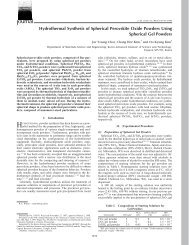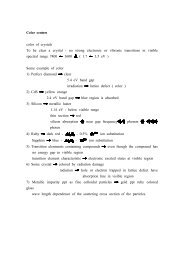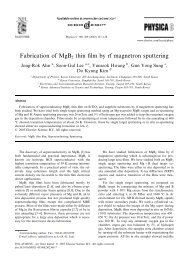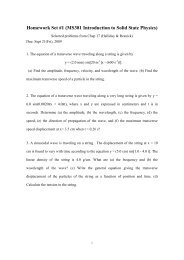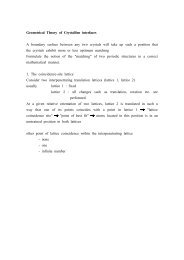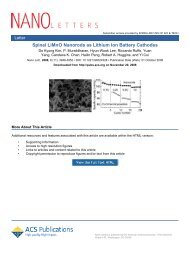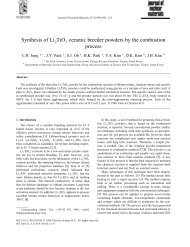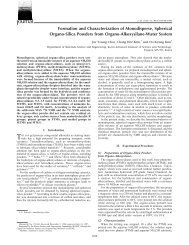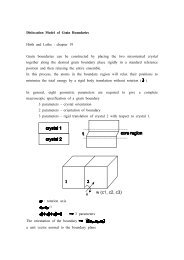Effect of Solvent on Titania Particle Formation and Morphology in
Effect of Solvent on Titania Particle Formation and Morphology in
Effect of Solvent on Titania Particle Formation and Morphology in
You also want an ePaper? Increase the reach of your titles
YUMPU automatically turns print PDFs into web optimized ePapers that Google loves.
J. Am. Ceram. Soc., 80 [3] 743–49 (1997)<br />
<str<strong>on</strong>g>Effect</str<strong>on</strong>g> <str<strong>on</strong>g>of</str<strong>on</strong>g> <str<strong>on</strong>g>Solvent</str<strong>on</strong>g> <strong>on</strong> <strong>Titania</strong> <strong>Particle</strong> Formati<strong>on</strong> <strong>and</strong> <strong>Morphology</strong> <strong>in</strong><br />
Thermal Hydrolysis <str<strong>on</strong>g>of</str<strong>on</strong>g> TiCl 4<br />
H<strong>on</strong>g Kyu Park, Do Kyung Kim, * <strong>and</strong> Ch<strong>on</strong>g Hee Kim *<br />
Department <str<strong>on</strong>g>of</str<strong>on</strong>g> Materials Science <strong>and</strong> Eng<strong>in</strong>eer<strong>in</strong>g, Korea Advanced Institute <str<strong>on</strong>g>of</str<strong>on</strong>g> Science <strong>and</strong> Technology,<br />
Taej<strong>on</strong> 305-701, Republic <str<strong>on</strong>g>of</str<strong>on</strong>g> Korea<br />
<strong>Titania</strong> powders were synthesized by the thermal hydrolysis research teams, however, found the above synthesis route difficult<br />
to reproduce. 9–12 Jean <strong>and</strong> R<strong>in</strong>g9,10 <str<strong>on</strong>g>of</str<strong>on</strong>g> titanium tetrachloride with the yield <str<strong>on</strong>g>of</str<strong>on</strong>g> above 85% <strong>in</strong> a<br />
showed that hydroxy-<br />
mixed solvent <str<strong>on</strong>g>of</str<strong>on</strong>g> n-propanol <strong>and</strong> water. The morphology <str<strong>on</strong>g>of</str<strong>on</strong>g> propyl cellulose provided steric stabilizati<strong>on</strong> dur<strong>in</strong>g the<br />
the precipitates was c<strong>on</strong>trolled by adjust<strong>in</strong>g the volume precipitati<strong>on</strong> <str<strong>on</strong>g>of</str<strong>on</strong>g> titania from alcohol soluti<strong>on</strong>, result<strong>in</strong>g <strong>in</strong> uni-<br />
ratio <str<strong>on</strong>g>of</str<strong>on</strong>g> n-propanol to water (RH ratio) <str<strong>on</strong>g>of</str<strong>on</strong>g> the mixed solvent. form particles with lower sensitivity to reacti<strong>on</strong> c<strong>on</strong>diti<strong>on</strong>.<br />
Precipitates obta<strong>in</strong>ed with an RH ratio <str<strong>on</strong>g>of</str<strong>on</strong>g> 0 were f<strong>in</strong>e, <strong>and</strong> More research results had <strong>in</strong>dicated that the powder morpholhighly<br />
agglomerated. In c<strong>on</strong>trast, an RH ratio <str<strong>on</strong>g>of</str<strong>on</strong>g> 3 resulted ogy is <strong>in</strong>fluenced by the properties <str<strong>on</strong>g>of</str<strong>on</strong>g> the solvent. Look <strong>and</strong><br />
Zukoski13–16 <strong>in</strong> precipitates c<strong>on</strong>sist<strong>in</strong>g <str<strong>on</strong>g>of</str<strong>on</strong>g> uniform <strong>and</strong> discrete particles.<br />
Accord<strong>in</strong>g to observati<strong>on</strong>s <str<strong>on</strong>g>of</str<strong>on</strong>g> the zeta potentials <str<strong>on</strong>g>of</str<strong>on</strong>g> precipi-<br />
tates <strong>and</strong> the dielectric c<strong>on</strong>stants <str<strong>on</strong>g>of</str<strong>on</strong>g> solvents, the discrete<br />
particles obta<strong>in</strong>ed with an RH ratio <str<strong>on</strong>g>of</str<strong>on</strong>g> 3 resulted from the<br />
low zeta potential <strong>and</strong> dielectric c<strong>on</strong>stant. The result <str<strong>on</strong>g>of</str<strong>on</strong>g><br />
dem<strong>on</strong>strated that particle <strong>in</strong>teracti<strong>on</strong> potentials<br />
play an important role <strong>in</strong> the development <str<strong>on</strong>g>of</str<strong>on</strong>g> precipitate morphology.<br />
They argued that the formati<strong>on</strong> <str<strong>on</strong>g>of</str<strong>on</strong>g> agglomerates <str<strong>on</strong>g>of</str<strong>on</strong>g><br />
discrete particles which have been fused together was due to a<br />
shallow sec<strong>on</strong>dary m<strong>in</strong>imum through a comb<strong>in</strong>ati<strong>on</strong> <str<strong>on</strong>g>of</str<strong>on</strong>g> electro-<br />
static <strong>and</strong> short-range repulsi<strong>on</strong>. Harris <strong>and</strong> Byers12 Fourier transform <strong>in</strong>frared (FTIR) spectroscopy showed<br />
the chemical <strong>in</strong>teracti<strong>on</strong> <str<strong>on</strong>g>of</str<strong>on</strong>g> particle surface with the solvent<br />
alcohol, which decreased the zeta potential <str<strong>on</strong>g>of</str<strong>on</strong>g> precipitates<br />
with an <strong>in</strong>crease <str<strong>on</strong>g>of</str<strong>on</strong>g> RH ratio. Add<strong>in</strong>g hydroxypropyl cellulose<br />
(HPC) as a steric dispersant made it possible to reduce<br />
the size <str<strong>on</strong>g>of</str<strong>on</strong>g> particles to the submicrometer range. <str<strong>on</strong>g>Effect</str<strong>on</strong>g>s<br />
extensively<br />
studied the effect <str<strong>on</strong>g>of</str<strong>on</strong>g> solvent <strong>on</strong> the morphology <str<strong>on</strong>g>of</str<strong>on</strong>g> titania pre-<br />
cipitates dur<strong>in</strong>g homogeneous precipitati<strong>on</strong> from an alcoholic<br />
aqueous soluti<strong>on</strong> <str<strong>on</strong>g>of</str<strong>on</strong>g> titanium ethoxide. They showed that particle<br />
growth was c<strong>on</strong>trolled by the surface phenomena <str<strong>on</strong>g>of</str<strong>on</strong>g> parti-<br />
cles <strong>and</strong> that the type <str<strong>on</strong>g>of</str<strong>on</strong>g> precipitates formed was affected by the<br />
solvent. Seog <strong>and</strong> Kim19 <str<strong>on</strong>g>of</str<strong>on</strong>g> the solvent <strong>on</strong> the formati<strong>on</strong> <strong>and</strong> morphology <str<strong>on</strong>g>of</str<strong>on</strong>g> the<br />
result<strong>in</strong>g particles were <strong>in</strong>vestigated.<br />
prepared m<strong>on</strong>odispersed, spherical<br />
silic<strong>on</strong> carbide particles by the carbothermal reacti<strong>on</strong> <str<strong>on</strong>g>of</str<strong>on</strong>g> spheri-<br />
cal precursor particles <strong>and</strong> showed that particle morphology<br />
was c<strong>on</strong>trolled by changes <strong>in</strong> the surface potential <str<strong>on</strong>g>of</str<strong>on</strong>g> the parti-<br />
I. Introducti<strong>on</strong> cles. Li <strong>and</strong> Mess<strong>in</strong>g21 prepared spherical zirc<strong>on</strong>ia particles<br />
IN RECENT years, significant research has been focused <strong>on</strong><br />
the low-temperature s<strong>in</strong>ter<strong>in</strong>g <str<strong>on</strong>g>of</str<strong>on</strong>g> ceramic devices. Improved<br />
s<strong>in</strong>terability has resulted from us<strong>in</strong>g particles with c<strong>on</strong>trolled<br />
by add<strong>in</strong>g n-PrOH to a zirc<strong>on</strong>ia aqueous sol with zirc<strong>on</strong>ia<br />
c<strong>on</strong>centrati<strong>on</strong> below 0.25 molal. Those workers reported that<br />
the role <str<strong>on</strong>g>of</str<strong>on</strong>g> n-PrOH dur<strong>in</strong>g particle formati<strong>on</strong> was to reduce the<br />
dielectric c<strong>on</strong>stant <str<strong>on</strong>g>of</str<strong>on</strong>g> sol. Recently, Mo<strong>on</strong> et al. 25,26 morphology, size, <strong>and</strong> size distributi<strong>on</strong>. <strong>Particle</strong>s, such as<br />
Al2O3, synthesized<br />
m<strong>on</strong>odispersed, spherical zirc<strong>on</strong>ia powders by the thermal<br />
1–3 SiO2, 4,5 Ta2O5, 6 TiO2, 7–18 SiC, 19 ZrO2, 20–26 <strong>and</strong><br />
27,28 BaTiO3 were prepared by the hydrolysis <str<strong>on</strong>g>of</str<strong>on</strong>g> metal alkoxides<br />
<strong>in</strong> a dilute alcohol soluti<strong>on</strong> <strong>and</strong> the thermal hydrolysis <str<strong>on</strong>g>of</str<strong>on</strong>g> metal<br />
salts <strong>in</strong> an aqueous soluti<strong>on</strong>.<br />
<strong>Titania</strong> has been studied extensively because <str<strong>on</strong>g>of</str<strong>on</strong>g> its wide<br />
applicati<strong>on</strong>s <strong>in</strong> pigments, photocatalysts, fillers, coat<strong>in</strong>gs, <strong>and</strong><br />
photoc<strong>on</strong>ductors. Generally, titania is obta<strong>in</strong>ed either from its<br />
hydrolysis <str<strong>on</strong>g>of</str<strong>on</strong>g> ZrOCl28H2O <strong>in</strong> a mixed solvent <str<strong>on</strong>g>of</str<strong>on</strong>g> iso-PrOH <strong>and</strong><br />
water. In that study, amorphous zirc<strong>on</strong>ia particles were prepared<br />
by thermal hydrolysis without pH c<strong>on</strong>trol <str<strong>on</strong>g>of</str<strong>on</strong>g> the mixed solvent.<br />
Their results also showed that the precipitati<strong>on</strong> was caused<br />
by reducti<strong>on</strong> <str<strong>on</strong>g>of</str<strong>on</strong>g> the dielectric c<strong>on</strong>stant <str<strong>on</strong>g>of</str<strong>on</strong>g> solvent. The effect<br />
<str<strong>on</strong>g>of</str<strong>on</strong>g> mixed solvent <strong>on</strong> precipitate morphology, however, was<br />
unclear.<br />
m<strong>in</strong>erals or from a soluti<strong>on</strong> <str<strong>on</strong>g>of</str<strong>on</strong>g> titanium salts or alkoxides. The present paper describes the preparati<strong>on</strong> <str<strong>on</strong>g>of</str<strong>on</strong>g> m<strong>on</strong>o-<br />
Indeed, numerous studies <strong>on</strong> aqueous soluti<strong>on</strong>s <str<strong>on</strong>g>of</str<strong>on</strong>g> titanium salts dispersed, spherical titania particles by the thermal hydrolysis<br />
have shown that titanium hydrolysis occurs even <strong>in</strong> highly<br />
acidic soluti<strong>on</strong>s (pH 1) <strong>and</strong> that boil<strong>in</strong>g the soluti<strong>on</strong>s acceler-<br />
<str<strong>on</strong>g>of</str<strong>on</strong>g> TiCl4 <strong>in</strong> a mixed solvent <str<strong>on</strong>g>of</str<strong>on</strong>g> n-PrOH <strong>and</strong> water. <str<strong>on</strong>g>Effect</str<strong>on</strong>g>s <str<strong>on</strong>g>of</str<strong>on</strong>g><br />
the solvent <strong>on</strong> the formati<strong>on</strong> <strong>and</strong> morphology <str<strong>on</strong>g>of</str<strong>on</strong>g> particles are<br />
ates hydrolysis <strong>and</strong>, c<strong>on</strong>sequently, titania precipitati<strong>on</strong>.<br />
F<strong>in</strong>e spherical particles with a narrow size distributi<strong>on</strong> are<br />
exam<strong>in</strong>ed <strong>in</strong> view <str<strong>on</strong>g>of</str<strong>on</strong>g> colloidal stability.<br />
desirable for produc<strong>in</strong>g advanced ceramics with enhanced<br />
reliability. Spherical titania particles have been prepared by<br />
II. Experimental Procedure<br />
chemical methods. Matijevic et al. 7 synthesized spherical titania<br />
particles <str<strong>on</strong>g>of</str<strong>on</strong>g> a narrow size distributi<strong>on</strong> by ag<strong>in</strong>g a highly<br />
acidic soluti<strong>on</strong> <str<strong>on</strong>g>of</str<strong>on</strong>g> TiCl4 at elevated temperatures for 6 to 47<br />
days. Barr<strong>in</strong>ger <strong>and</strong> Bowen<br />
(1) Preparati<strong>on</strong> <str<strong>on</strong>g>of</str<strong>on</strong>g> Start<strong>in</strong>g Soluti<strong>on</strong><br />
Titanium tetrachloride (98% TiCl4, Wako Chemical Indus-<br />
tries, Japan) was used as a start<strong>in</strong>g material. When TiCl4 dis-<br />
8 obta<strong>in</strong>ed uniform titania particles<br />
from alcoholic soluti<strong>on</strong>s <str<strong>on</strong>g>of</str<strong>on</strong>g> titanium alkoxides. Several other<br />
solved <strong>in</strong> water, the heat <str<strong>on</strong>g>of</str<strong>on</strong>g> the exothermic reacti<strong>on</strong> explosively<br />
generated the formati<strong>on</strong> <str<strong>on</strong>g>of</str<strong>on</strong>g> orthotitanic acid [Ti(OH) 4]. Because<br />
the formati<strong>on</strong> <str<strong>on</strong>g>of</str<strong>on</strong>g> that species disturbed homogeneous precipitati<strong>on</strong>,<br />
5 mL (per 100 mL distilled, dei<strong>on</strong>ized water) <str<strong>on</strong>g>of</str<strong>on</strong>g> hydro-<br />
Charles F. Zukoski—c<strong>on</strong>tribut<strong>in</strong>g editor chloric acid (35% HCl, Junsei Chemical Company, Japan) was<br />
added to prevent the formati<strong>on</strong> <str<strong>on</strong>g>of</str<strong>on</strong>g> orthotitanic acid.<br />
Titanium tetrachloride was dissolved <strong>in</strong> triple-distilled,<br />
Manuscript No. 192246. Received October 19, 1995; approved September 30, 1996.<br />
Supported by the Korea Science <strong>and</strong> Eng<strong>in</strong>eer<strong>in</strong>g Foundati<strong>on</strong> through the Center<br />
for Interface Science <strong>and</strong> Eng<strong>in</strong>eer<strong>in</strong>g <str<strong>on</strong>g>of</str<strong>on</strong>g> Materials.<br />
*Member, American Ceramic Society.<br />
dei<strong>on</strong>ized water. The c<strong>on</strong>centrati<strong>on</strong> <str<strong>on</strong>g>of</str<strong>on</strong>g> titanium was adjusted to<br />
1M. This aqueous soluti<strong>on</strong> was then mixed with n-PrOH (98%,<br />
Junsei) to adjust the volume ratio <str<strong>on</strong>g>of</str<strong>on</strong>g> n-PrOH to water (the RH<br />
743
744<br />
Fig. 1. Variati<strong>on</strong> <str<strong>on</strong>g>of</str<strong>on</strong>g> the precipitati<strong>on</strong> temperature <strong>and</strong> dielectric c<strong>on</strong>-<br />
stant <str<strong>on</strong>g>of</str<strong>on</strong>g> the solvent with the RH ratio. The TiCl4 c<strong>on</strong>centrati<strong>on</strong> <str<strong>on</strong>g>of</str<strong>on</strong>g> the<br />
soluti<strong>on</strong> was 0.1 mol/L.<br />
Journal <str<strong>on</strong>g>of</str<strong>on</strong>g> the American Ceramic Society— Park et al. Vol. 80, No. 3<br />
Fig. 2. Yield <str<strong>on</strong>g>of</str<strong>on</strong>g> precipitates formed at various reacti<strong>on</strong> times as a<br />
functi<strong>on</strong> <str<strong>on</strong>g>of</str<strong>on</strong>g> RH. The reacti<strong>on</strong> temperature was 70C.<br />
ratio) to 0, 1, 2, 3, 4, <strong>and</strong> 5. The f<strong>in</strong>al c<strong>on</strong>centrati<strong>on</strong> <str<strong>on</strong>g>of</str<strong>on</strong>g> TiCl4 <strong>in</strong><br />
the mixed soluti<strong>on</strong> was 0.1 mol/L. A homogeneous soluti<strong>on</strong><br />
was obta<strong>in</strong>ed by stirr<strong>in</strong>g for 6 h with a magnetic stirrer at 10C.<br />
All <str<strong>on</strong>g>of</str<strong>on</strong>g> the reagents were used as received. A l<strong>on</strong>g-cha<strong>in</strong>ed<br />
molecule, hydroxypropyl cellulose (HPC) (molecular weight<br />
100 000, Aldrich Chemical Company, Milwaukee, WI) was<br />
used as a steric dispersant.<br />
determ<strong>in</strong>e the <strong>in</strong>teracti<strong>on</strong> between the solvent <strong>and</strong> the particle<br />
surface. Precipitate samples were mixed with dry KBr, <strong>and</strong> the<br />
FTIR cell was purged for 20 m<strong>in</strong> prior to spectral collecti<strong>on</strong>.<br />
FTIR spectroscopy was used with a dry air purge. The yield <str<strong>on</strong>g>of</str<strong>on</strong>g><br />
precipitates was determ<strong>in</strong>ed by divid<strong>in</strong>g the weight <str<strong>on</strong>g>of</str<strong>on</strong>g> product<br />
dried at 1000C for 3 h by the weight <str<strong>on</strong>g>of</str<strong>on</strong>g> product when n mol <str<strong>on</strong>g>of</str<strong>on</strong>g><br />
titania was formed from n mole <str<strong>on</strong>g>of</str<strong>on</strong>g> titanium tetrachloride.<br />
(2) Synthesis <str<strong>on</strong>g>of</str<strong>on</strong>g> M<strong>on</strong>odispersed Spherical <strong>Titania</strong> Powders<br />
III. Results <strong>and</strong> Discussi<strong>on</strong><br />
When the start<strong>in</strong>g soluti<strong>on</strong> was heated <strong>in</strong> an isothermal water<br />
bath <str<strong>on</strong>g>of</str<strong>on</strong>g> 70C for a few m<strong>in</strong>utes, it became supersaturated <strong>and</strong><br />
precipitated. The soluti<strong>on</strong> was then aged further to precipitate<br />
growth. After precipitati<strong>on</strong>, the mother liquors were neutralized<br />
with an NH4OH–n-PrOH (0.5M NH4OH) soluti<strong>on</strong> to remove<br />
chloride i<strong>on</strong>. The precipitates next were separated from the<br />
mother liquor, by centrifug<strong>in</strong>g at 10 000 rpm, then washed<br />
twice with distilled water <strong>and</strong> f<strong>in</strong>ally with n-PrOH. The washed<br />
precipitates were dried <strong>in</strong> a vacuum oven at 60C for 24 h.<br />
An experiment was carried out to reveal the effect <str<strong>on</strong>g>of</str<strong>on</strong>g> the<br />
dispers<strong>in</strong>g soluti<strong>on</strong> <str<strong>on</strong>g>of</str<strong>on</strong>g> precipitates <strong>on</strong> the particle morphology.<br />
<strong>Titania</strong> precipitates were obta<strong>in</strong>ed by ag<strong>in</strong>g the TiCl4 aqueous<br />
soluti<strong>on</strong> with titanium c<strong>on</strong>centrati<strong>on</strong> <str<strong>on</strong>g>of</str<strong>on</strong>g> 0.5 mol/L at 80C.<br />
The precipitates were separated centrifugally from the mother<br />
(1) Precipitati<strong>on</strong> Behavior <strong>in</strong> Mixed <str<strong>on</strong>g>Solvent</str<strong>on</strong>g><br />
When the start<strong>in</strong>g soluti<strong>on</strong> is heated at a rate <str<strong>on</strong>g>of</str<strong>on</strong>g> 10C/m<strong>in</strong>, it<br />
becomes turbid at a certa<strong>in</strong> temperature, def<strong>in</strong>ed as the “precipi-<br />
tati<strong>on</strong> temperature” <str<strong>on</strong>g>of</str<strong>on</strong>g> the soluti<strong>on</strong>. The precipitati<strong>on</strong> tempera-<br />
ture was determ<strong>in</strong>ed by the usual observati<strong>on</strong>, a turbidimeter<br />
(4700, Malvern, UK) <strong>on</strong> light scatter<strong>in</strong>g. Figure 1 shows the<br />
precipitati<strong>on</strong> temperature as a functi<strong>on</strong> <str<strong>on</strong>g>of</str<strong>on</strong>g> the RH ratio <str<strong>on</strong>g>of</str<strong>on</strong>g><br />
the solvent. The precipitati<strong>on</strong> temperature decreases with an<br />
<strong>in</strong>crease <strong>in</strong> the RH ratio, exhibit<strong>in</strong>g a m<strong>in</strong>imum at the RH ratio<br />
<str<strong>on</strong>g>of</str<strong>on</strong>g> 3. Further <strong>in</strong>creases <strong>in</strong> the RH ratio cause the precipitati<strong>on</strong><br />
temperature to <strong>in</strong>crease slightly. The dielectric c<strong>on</strong>stants <str<strong>on</strong>g>of</str<strong>on</strong>g> the<br />
start<strong>in</strong>g soluti<strong>on</strong>s at the precipitati<strong>on</strong> temperature are also<br />
shown <strong>in</strong> Fig. 1. The dielectric c<strong>on</strong>stant decreases as the RH<br />
ratio <strong>in</strong>creases. Accord<strong>in</strong>g to previous studies, 29,30 liquor <strong>and</strong> redispersed with distilled water, methanol, ethanol,<br />
<strong>and</strong> n-propanol, respectively. The dispersed suspensi<strong>on</strong>s were<br />
stirred for 3 h <strong>and</strong> separated <strong>in</strong>to precipitates <strong>and</strong> supernatant.<br />
The precipitates were then dried by the same procedures.<br />
(3) Characterizati<strong>on</strong> <str<strong>on</strong>g>of</str<strong>on</strong>g> the <strong>Titania</strong> <strong>Particle</strong>s<br />
The particle size <strong>and</strong> morphology were analyzed by scann<strong>in</strong>g<br />
electr<strong>on</strong> microscopy (SEM). The <strong>in</strong>ner structures <str<strong>on</strong>g>of</str<strong>on</strong>g> the<br />
precipitates were observed by transmissi<strong>on</strong> electr<strong>on</strong> microscopy<br />
(TEM). To study the <strong>in</strong>ner structure <str<strong>on</strong>g>of</str<strong>on</strong>g> spherical particles,<br />
a small amount <str<strong>on</strong>g>of</str<strong>on</strong>g> powders, mixed homogeneously with epoxy<br />
(55 vol% LX-112 res<strong>in</strong>, 43 vol% NMA hardener, <strong>and</strong> 2 vol%<br />
DMT-30 catalyst, Ladd Research Industries, Burl<strong>in</strong>gt<strong>on</strong>, Verm<strong>on</strong>t),<br />
was cured at 80C for 144 h. The specimen for TEM<br />
observati<strong>on</strong> was then th<strong>in</strong>ned by polish<strong>in</strong>g, mechanical dimpl<strong>in</strong>g,<br />
<strong>and</strong> i<strong>on</strong> th<strong>in</strong>n<strong>in</strong>g.<br />
The zeta potential <str<strong>on</strong>g>of</str<strong>on</strong>g> precipitates was measured by use <str<strong>on</strong>g>of</str<strong>on</strong>g> an<br />
electrophoretic technique (Zetamaster, Malvern, UK) at 20C.<br />
precipitati<strong>on</strong><br />
can occur by heat<strong>in</strong>g a salt soluti<strong>on</strong> <str<strong>on</strong>g>of</str<strong>on</strong>g> alcohol–water, because<br />
the dielectric c<strong>on</strong>stant <str<strong>on</strong>g>of</str<strong>on</strong>g> the soluti<strong>on</strong> is decreased significantly<br />
with an <strong>in</strong>crease <strong>in</strong> temperature. Similarly, it seems that a<br />
decrease <strong>in</strong> the dielectric c<strong>on</strong>stant <str<strong>on</strong>g>of</str<strong>on</strong>g> the mixed solvent promotes<br />
the precipitati<strong>on</strong> <str<strong>on</strong>g>of</str<strong>on</strong>g> titania by reduc<strong>in</strong>g the solubility <str<strong>on</strong>g>of</str<strong>on</strong>g><br />
the titania <strong>in</strong> the mixed solvent. For the RH ratio <str<strong>on</strong>g>of</str<strong>on</strong>g> 5, precipi-<br />
tates were not formed even at the temperature <str<strong>on</strong>g>of</str<strong>on</strong>g> 70C, despite<br />
the lower dielectric c<strong>on</strong>stant <str<strong>on</strong>g>of</str<strong>on</strong>g> the solvent. When more water<br />
was added to the solvent at that temperature, precipitates<br />
formed abruptly. Apparently, no precipitati<strong>on</strong> occurs, even at<br />
the lower dielectric c<strong>on</strong>stant <str<strong>on</strong>g>of</str<strong>on</strong>g> the higher-temperature solvent,<br />
because the amount <str<strong>on</strong>g>of</str<strong>on</strong>g> water required for the hydrolysis <str<strong>on</strong>g>of</str<strong>on</strong>g><br />
TiCl4 becomes deficient at an RH ratio above 4.<br />
Figure 2 shows the yield <str<strong>on</strong>g>of</str<strong>on</strong>g> precipitates formed at various<br />
reacti<strong>on</strong> times at 70C as a functi<strong>on</strong> <str<strong>on</strong>g>of</str<strong>on</strong>g> the RH ratio. As the RH<br />
The samples for measur<strong>in</strong>g the zeta potentials <str<strong>on</strong>g>of</str<strong>on</strong>g> as-precipitates<br />
were prepared by the follow<strong>in</strong>g route. Screw-cap covered test<br />
tubes c<strong>on</strong>ta<strong>in</strong><strong>in</strong>g a porti<strong>on</strong> <str<strong>on</strong>g>of</str<strong>on</strong>g> the start<strong>in</strong>g soluti<strong>on</strong>s were kept <strong>in</strong><br />
an isothermal vessel. After a desired period <str<strong>on</strong>g>of</str<strong>on</strong>g> reacti<strong>on</strong> time,<br />
the tubes were cooled <strong>and</strong> the supernatant soluti<strong>on</strong>s decanted<br />
<strong>in</strong>to other tubes. A small amount <str<strong>on</strong>g>of</str<strong>on</strong>g> precipitates was redispersed<br />
<strong>in</strong> the decanted supernatant to preserve the i<strong>on</strong>ic strength <str<strong>on</strong>g>of</str<strong>on</strong>g><br />
the soluti<strong>on</strong>.<br />
Fourier transform <strong>in</strong>frared (FTIR) spectroscopy (Nicolet<br />
800, Nicolet Instrument Company, Madis<strong>on</strong>, WI) was used to<br />
Table I. Dielectric C<strong>on</strong>stants <str<strong>on</strong>g>of</str<strong>on</strong>g> Mixed <str<strong>on</strong>g>Solvent</str<strong>on</strong>g>s <strong>and</strong><br />
Zeta Potentials <strong>and</strong> Morphologies <str<strong>on</strong>g>of</str<strong>on</strong>g> Precipitates with the<br />
RH Ratios <str<strong>on</strong>g>of</str<strong>on</strong>g> Mixed <str<strong>on</strong>g>Solvent</str<strong>on</strong>g>s<br />
Dielectric c<strong>on</strong>stant <str<strong>on</strong>g>of</str<strong>on</strong>g> Zeta potential at<br />
RH ratio solvent at 20C 20C <strong>Particle</strong> morphology<br />
0 80 18.3 F<strong>in</strong>e, aggregated<br />
1 48 11.4 Aggregated<br />
2 36 6.7 Spherical, aggregated<br />
3 32 4.5 Spherical, discrete
March 1997 <str<strong>on</strong>g>Effect</str<strong>on</strong>g> <str<strong>on</strong>g>of</str<strong>on</strong>g> <str<strong>on</strong>g>Solvent</str<strong>on</strong>g> <strong>on</strong> <strong>Titania</strong> <strong>Particle</strong> Formati<strong>on</strong> <strong>and</strong> <strong>Morphology</strong> <strong>in</strong> Thermal Hydrolysis <str<strong>on</strong>g>of</str<strong>on</strong>g> TiCl4 745<br />
(A)<br />
(B)<br />
Fig. 3. SEM micrographs <str<strong>on</strong>g>of</str<strong>on</strong>g> the precursor particles obta<strong>in</strong>ed at RH ratios <str<strong>on</strong>g>of</str<strong>on</strong>g> (A) 0 <strong>and</strong> (B) 3.<br />
ratio <strong>in</strong>creases, the yield <str<strong>on</strong>g>of</str<strong>on</strong>g> precipitates <strong>in</strong>creases at the same precipitates are very high. Accord<strong>in</strong>g to Eq. (1), the potential<br />
reacti<strong>on</strong> time. While the yield <str<strong>on</strong>g>of</str<strong>on</strong>g> the precipitates obta<strong>in</strong>ed <strong>in</strong> the energy barrier is relatively high. Under this c<strong>on</strong>diti<strong>on</strong>, relatively<br />
solvent with an RH ratio <str<strong>on</strong>g>of</str<strong>on</strong>g> 0 is 58% after a reacti<strong>on</strong> time <str<strong>on</strong>g>of</str<strong>on</strong>g> small particles may be stable aga<strong>in</strong>st the aggregati<strong>on</strong>, <strong>and</strong> the<br />
20 m<strong>in</strong>, the RH ratio <str<strong>on</strong>g>of</str<strong>on</strong>g> 3 gives a yield <str<strong>on</strong>g>of</str<strong>on</strong>g> 85%. These results<br />
seem to <strong>in</strong>dicate that the reduced dielectric c<strong>on</strong>stant <str<strong>on</strong>g>of</str<strong>on</strong>g> a mixed<br />
solvent promotes the supersaturati<strong>on</strong> <str<strong>on</strong>g>of</str<strong>on</strong>g> titania <strong>in</strong> the solvent.<br />
result<strong>in</strong>g particles appear to be f<strong>in</strong>e as shown <strong>in</strong> Fig. 3(A). In<br />
the case <str<strong>on</strong>g>of</str<strong>on</strong>g> the solvent with an RH ratio <str<strong>on</strong>g>of</str<strong>on</strong>g> 3, the zeta<br />
potential <strong>and</strong> the dielectric c<strong>on</strong>stant are low. The precipitates<br />
(2) <str<strong>on</strong>g>Effect</str<strong>on</strong>g> <str<strong>on</strong>g>of</str<strong>on</strong>g> Mixed <str<strong>on</strong>g>Solvent</str<strong>on</strong>g>s <strong>on</strong> <strong>Particle</strong> <strong>Morphology</strong><br />
The compositi<strong>on</strong> <str<strong>on</strong>g>of</str<strong>on</strong>g> mixed solvents also affects the morphol-<br />
ogy <str<strong>on</strong>g>of</str<strong>on</strong>g> the result<strong>in</strong>g particles. Figure 3 shows the particles<br />
obta<strong>in</strong>ed at the RH ratios <str<strong>on</strong>g>of</str<strong>on</strong>g> 0 <strong>and</strong> 3. For an RH ratio <str<strong>on</strong>g>of</str<strong>on</strong>g> 0,<br />
the precipitated particles are found to be very f<strong>in</strong>e <strong>and</strong> highly<br />
agglomerated. In c<strong>on</strong>trast, the particles formed at an RH ratio<br />
<str<strong>on</strong>g>of</str<strong>on</strong>g> 3 are spherical <strong>and</strong> discrete particles, with some doublets<br />
fused together. These differences <strong>in</strong> morphologies <strong>in</strong>dicate that<br />
have a low potential energy barrier <strong>and</strong> maximum repulsive<br />
force. Therefore, the colloidal stability <str<strong>on</strong>g>of</str<strong>on</strong>g> the precipitates<br />
<strong>in</strong>creases with the particle size <strong>in</strong>crease, because the potential<br />
energy barrier <strong>and</strong> the maximum repulsive force <strong>in</strong>crease with<br />
the particle size. C<strong>on</strong>sequently, the result<strong>in</strong>g precipitates,<br />
shown <strong>in</strong> Fig. 3(B), are composed <str<strong>on</strong>g>of</str<strong>on</strong>g> large <strong>and</strong> discrete parti-<br />
cles. These results show that the compositi<strong>on</strong> <str<strong>on</strong>g>of</str<strong>on</strong>g> the mixed<br />
solvent affects the particle size <strong>and</strong> morphology through the<br />
change <str<strong>on</strong>g>of</str<strong>on</strong>g> the zeta potential <str<strong>on</strong>g>of</str<strong>on</strong>g> precipitates <strong>and</strong> the dielectric<br />
the colloidal stability <str<strong>on</strong>g>of</str<strong>on</strong>g> the precipitated particles <strong>in</strong> the mixed<br />
solvent <str<strong>on</strong>g>of</str<strong>on</strong>g> n-PrOH–water is different from that <str<strong>on</strong>g>of</str<strong>on</strong>g> water solvent.<br />
These results can be understood by c<strong>on</strong>sider<strong>in</strong>g the parameters<br />
determ<strong>in</strong><strong>in</strong>g the colloidal stability. 19,26,31 Typically, the maximum<br />
repulsive force can be estimated from the equati<strong>on</strong> <str<strong>on</strong>g>of</str<strong>on</strong>g><br />
2ε 0ε r2 for electrostatically stabilized particles, where ε0 is the permittivity <strong>in</strong> free space, εr the dielectric c<strong>on</strong>stant <str<strong>on</strong>g>of</str<strong>on</strong>g> the<br />
c<strong>on</strong>t<strong>in</strong>uous phase, the Debye–Hückel parameter, the particle<br />
diameter, <strong>and</strong> the particle surface potential. 13–15 Under the<br />
c<strong>on</strong>stant i<strong>on</strong>ic strength <str<strong>on</strong>g>of</str<strong>on</strong>g> the solvent, the maximum repulsive<br />
force depends <strong>on</strong> the particle surface potential, the dielectric<br />
c<strong>on</strong>stant, <strong>and</strong> the particle size. Accord<strong>in</strong>g to Derjaqu<strong>in</strong>–<br />
L<strong>and</strong>au–Verwey–Overbeek (DLVO) theory, 31 the energy barrier<br />
between two particles which <strong>in</strong>hibit agglomerati<strong>on</strong> can be also<br />
expressed as<br />
Vb A<br />
12 2ε 0ε r2 (1)<br />
where A is the effective Hamaker c<strong>on</strong>stant. The effective<br />
Hamaker c<strong>on</strong>stant depends <strong>on</strong> the dispersi<strong>on</strong> medium. The<br />
Hamaker c<strong>on</strong>stants <str<strong>on</strong>g>of</str<strong>on</strong>g> water <strong>and</strong> several aliphatic alcohols <strong>in</strong><br />
free space are reported to have similar values, <strong>on</strong> the order <str<strong>on</strong>g>of</str<strong>on</strong>g><br />
10 20 J. 31,32 C<strong>on</strong>sider<strong>in</strong>g that the mixed solvent is composed <str<strong>on</strong>g>of</str<strong>on</strong>g><br />
alcohol <strong>and</strong> water, the mixed solvent may not greatly <strong>in</strong>fluence<br />
the effective Hamaker c<strong>on</strong>stant. 31,32 Additi<strong>on</strong>ally, there were no<br />
electrolytes <strong>in</strong> the mixed solvents <strong>in</strong> the present work, except<br />
for HCl added to <strong>in</strong>hibit the precipitati<strong>on</strong> <str<strong>on</strong>g>of</str<strong>on</strong>g> orthotitanic acid<br />
dur<strong>in</strong>g dissolv<strong>in</strong>g the TiCl 4 <strong>in</strong> water. Therefore, the i<strong>on</strong>ic<br />
strength is supposed to be c<strong>on</strong>stant <strong>in</strong> the solvent. Under these<br />
c<strong>on</strong>diti<strong>on</strong>s, the magnitude <str<strong>on</strong>g>of</str<strong>on</strong>g> the energy barrier <strong>and</strong> maximum<br />
repulsive force is determ<strong>in</strong>ed ma<strong>in</strong>ly by the surface potential,<br />
the dielectric c<strong>on</strong>stant, <strong>and</strong> the particle size.<br />
The dielectric c<strong>on</strong>stants, the zeta potentials <strong>and</strong> the precipitate<br />
morphologies are summarized <strong>in</strong> Table I. As the RH ratio <str<strong>on</strong>g>of</str<strong>on</strong>g><br />
solvent <strong>in</strong>creases, the zeta potentials <strong>and</strong> the dielectric c<strong>on</strong>stants<br />
c<strong>on</strong>stant <str<strong>on</strong>g>of</str<strong>on</strong>g> the mixed solvent.<br />
rapidly decrease. For the solvent with an RH ratio <str<strong>on</strong>g>of</str<strong>on</strong>g> 0, the Fig. 4. FTIR spectra <str<strong>on</strong>g>of</str<strong>on</strong>g> the precipitates formed with an RH ratio <str<strong>on</strong>g>of</str<strong>on</strong>g><br />
dielectric c<strong>on</strong>stant <str<strong>on</strong>g>of</str<strong>on</strong>g> the solvent <strong>and</strong> the zeta potential <str<strong>on</strong>g>of</str<strong>on</strong>g> the<br />
(A) 0 <strong>and</strong> (B) 3.
746<br />
Journal <str<strong>on</strong>g>of</str<strong>on</strong>g> the American Ceramic Society— Park et al. Vol. 80, No. 3<br />
Table II. Carb<strong>on</strong> Analysis <str<strong>on</strong>g>of</str<strong>on</strong>g> the <strong>Particle</strong>s Prepared from the <strong>and</strong> above the po<strong>in</strong>t <str<strong>on</strong>g>of</str<strong>on</strong>g> zero charge, respectively. 35 The c<strong>on</strong>cen-<br />
Different Processes<br />
trati<strong>on</strong> <str<strong>on</strong>g>of</str<strong>on</strong>g> potential determ<strong>in</strong><strong>in</strong>g i<strong>on</strong>s is determ<strong>in</strong>ed ma<strong>in</strong>ly by<br />
Sample name Dispers<strong>in</strong>g soluti<strong>on</strong> Carb<strong>on</strong> c<strong>on</strong>tent (wt%)<br />
Sample A* H2O 0<br />
Sample B* n-propanol 2.04<br />
Sample C<br />
the pH <str<strong>on</strong>g>of</str<strong>on</strong>g> the soluti<strong>on</strong> under c<strong>on</strong>stant i<strong>on</strong>ic strength. In this<br />
work, as shown <strong>in</strong> Table I, the zeta potential <str<strong>on</strong>g>of</str<strong>on</strong>g> particles<br />
decreases with the <strong>in</strong>crease <str<strong>on</strong>g>of</str<strong>on</strong>g> the RH ratio <str<strong>on</strong>g>of</str<strong>on</strong>g> the solvent<br />
without the pH c<strong>on</strong>trol <str<strong>on</strong>g>of</str<strong>on</strong>g> the solvent. These results <strong>in</strong>dicate that<br />
‡ n-propanol 8.5<br />
the potential-determ<strong>in</strong><strong>in</strong>g i<strong>on</strong>s (H3O *Precipitated <strong>in</strong> the RH ratio <str<strong>on</strong>g>of</str<strong>on</strong>g> 0.<br />
) <strong>on</strong> the particle surface<br />
† Precipitated <strong>in</strong> the RH ratio <str<strong>on</strong>g>of</str<strong>on</strong>g> 3.<br />
decrease under the c<strong>on</strong>stant pH <str<strong>on</strong>g>of</str<strong>on</strong>g> the solvent. C<strong>on</strong>sider<strong>in</strong>g the<br />
FTIR, the low zeta potential <str<strong>on</strong>g>of</str<strong>on</strong>g> the precipitates <strong>in</strong> the mixed<br />
solvent (with RH ratio <str<strong>on</strong>g>of</str<strong>on</strong>g> 3) is attributed to the chemical adsorp-<br />
(3) Interacti<strong>on</strong> <str<strong>on</strong>g>of</str<strong>on</strong>g> Mixed <str<strong>on</strong>g>Solvent</str<strong>on</strong>g>s with <strong>Particle</strong>s<br />
Figure 4 shows the FTIR spectra <str<strong>on</strong>g>of</str<strong>on</strong>g> titania precipitates,<br />
obta<strong>in</strong>ed at the RH ratios <str<strong>on</strong>g>of</str<strong>on</strong>g> 0 <strong>and</strong> 3, after dry<strong>in</strong>g. In both<br />
spectra, the broad absorpti<strong>on</strong> b<strong>and</strong>s corresp<strong>on</strong>d<strong>in</strong>g to an O–H<br />
stretch appear from 3600 to 3000 cm<br />
ti<strong>on</strong> <str<strong>on</strong>g>of</str<strong>on</strong>g> alcohol <strong>on</strong> the particle surface. Table II shows the result<br />
<str<strong>on</strong>g>of</str<strong>on</strong>g> carb<strong>on</strong> analysis performed <strong>on</strong> precipitates prepared by different<br />
processes. The carb<strong>on</strong> c<strong>on</strong>tents <str<strong>on</strong>g>of</str<strong>on</strong>g> sample A obta<strong>in</strong>ed from<br />
TiCl4 aqueous soluti<strong>on</strong> is 0 wt%. When sample A is redispersed<br />
<strong>in</strong> n-PrOH (sample B), it c<strong>on</strong>ta<strong>in</strong>ed 2.05 wt% <str<strong>on</strong>g>of</str<strong>on</strong>g> carb<strong>on</strong>. In<br />
1 , <strong>and</strong> the two peaks<br />
centered approximately at 1620 <strong>and</strong> 1350 cm<br />
c<strong>on</strong>trast, <strong>in</strong> the case that precipitates are obta<strong>in</strong>ed <strong>in</strong> the solvent<br />
1 corresp<strong>on</strong>d to<br />
CO2 adsorbed <strong>on</strong> the surface <str<strong>on</strong>g>of</str<strong>on</strong>g> the particle.<br />
with an RH ratio <str<strong>on</strong>g>of</str<strong>on</strong>g> 3 (sample C), the carb<strong>on</strong> c<strong>on</strong>tent is 8.5 wt%.<br />
24,33,34 The spectrum<br />
<str<strong>on</strong>g>of</str<strong>on</strong>g> the precipitate obta<strong>in</strong>ed with an RH ratio <str<strong>on</strong>g>of</str<strong>on</strong>g> 3 reveals new<br />
absorpti<strong>on</strong> b<strong>and</strong>s (Fig. 4(B)). The absorpti<strong>on</strong> b<strong>and</strong>s at 3000 <strong>and</strong><br />
2900 cm<br />
It is believed that these results also support the <strong>in</strong>teracti<strong>on</strong><br />
between titania precipitate <strong>and</strong> n-PrOH <strong>in</strong> the mixed solvent <str<strong>on</strong>g>of</str<strong>on</strong>g><br />
n-PrOH <strong>and</strong> water.<br />
1 are due to C–H stretch<strong>in</strong>g. The small peaks at 1160<br />
<strong>and</strong> 1063 cm (4) <str<strong>on</strong>g>Effect</str<strong>on</strong>g> <str<strong>on</strong>g>of</str<strong>on</strong>g> Alcohol <strong>on</strong> <strong>Particle</strong> Growth<br />
1 corresp<strong>on</strong>d to the C–O stretch<strong>in</strong>g <strong>in</strong> term<strong>in</strong>al<br />
titanium alkoxide. 33,34 Absorpti<strong>on</strong>s due to C–O stretch<strong>in</strong>g <strong>in</strong><br />
excess propanol are not observed, which may be due to the<br />
overlap with water <strong>and</strong> carb<strong>on</strong> dioxide. C<strong>on</strong>sider<strong>in</strong>g that the<br />
Generally, the primary particles nucleated from soluti<strong>on</strong>s are<br />
known to grow by molecular additi<strong>on</strong> or aggregati<strong>on</strong> with small<br />
subunits. 14–16 start<strong>in</strong>g soluti<strong>on</strong>s are composed <str<strong>on</strong>g>of</str<strong>on</strong>g> TiCl4, n-PrOH, <strong>and</strong> water,<br />
the formati<strong>on</strong> <str<strong>on</strong>g>of</str<strong>on</strong>g> term<strong>in</strong>al titanium alkoxide is due to the b<strong>on</strong>d<strong>in</strong>g<br />
between the oxygen <str<strong>on</strong>g>of</str<strong>on</strong>g> Ti(OH) 4 <strong>and</strong> the carb<strong>on</strong> <str<strong>on</strong>g>of</str<strong>on</strong>g> R (C3H7). Accord<strong>in</strong>g to the stabilizati<strong>on</strong> <str<strong>on</strong>g>of</str<strong>on</strong>g> colloids by electrostatic<br />
The particle growth after nucleati<strong>on</strong> can be also<br />
affected by the k<strong>in</strong>ds <str<strong>on</strong>g>of</str<strong>on</strong>g> solvents, because the particle <strong>in</strong>ter-<br />
acti<strong>on</strong> potential is different <strong>in</strong> each solvent. Figure 5 shows<br />
the morphologies <str<strong>on</strong>g>of</str<strong>on</strong>g> precipitates, prepared from TiCl4 aqueous<br />
soluti<strong>on</strong>, redispersed <strong>in</strong> distilled water <strong>and</strong> various alcohols.<br />
<strong>in</strong>teracti<strong>on</strong>, the surface potential <str<strong>on</strong>g>of</str<strong>on</strong>g> oxide particles is deter- The precipitates redispersed <strong>in</strong> distilled water c<strong>on</strong>sist <str<strong>on</strong>g>of</str<strong>on</strong>g> f<strong>in</strong>e<br />
m<strong>in</strong>ed by the charges <str<strong>on</strong>g>of</str<strong>on</strong>g> potential determ<strong>in</strong><strong>in</strong>g i<strong>on</strong>s. For hydrous <strong>and</strong> subunit particles. The precipitate size is about 0.05 m. In<br />
oxides, the charge-determ<strong>in</strong><strong>in</strong>g i<strong>on</strong>s are H3O c<strong>on</strong>trast, the precipitates redispersed <strong>in</strong> alcohols are found to<br />
<strong>and</strong> OH below<br />
(A) (B)<br />
(C) (D)<br />
Fig. 5. SEM micrographs <str<strong>on</strong>g>of</str<strong>on</strong>g> the precipitates redispersed <strong>in</strong> distilled water <strong>and</strong> various alcohols for 3 h. The dispers<strong>in</strong>g soluti<strong>on</strong>s <str<strong>on</strong>g>of</str<strong>on</strong>g> (A), (B), (C),<br />
<strong>and</strong> (D) are distilled water, methanol, ethanol, <strong>and</strong> n-propanol, respectively.
March 1997 <str<strong>on</strong>g>Effect</str<strong>on</strong>g> <str<strong>on</strong>g>of</str<strong>on</strong>g> <str<strong>on</strong>g>Solvent</str<strong>on</strong>g> <strong>on</strong> <strong>Titania</strong> <strong>Particle</strong> Formati<strong>on</strong> <strong>and</strong> <strong>Morphology</strong> <strong>in</strong> Thermal Hydrolysis <str<strong>on</strong>g>of</str<strong>on</strong>g> TiCl4 747<br />
(A) (B)<br />
Fig. 6. TEM micrographs <str<strong>on</strong>g>of</str<strong>on</strong>g> the <strong>in</strong>ner structure <str<strong>on</strong>g>of</str<strong>on</strong>g> the precursor particle obta<strong>in</strong>ed at the RH ratio <str<strong>on</strong>g>of</str<strong>on</strong>g> 3.<br />
be composed <str<strong>on</strong>g>of</str<strong>on</strong>g> spherical sec<strong>on</strong>dary particles, as shown <strong>in</strong> c<strong>on</strong>stant. Those precipitates show rapid aggregative growth as<br />
Fig. 5(B, C, <strong>and</strong> D). The size <str<strong>on</strong>g>of</str<strong>on</strong>g> the sec<strong>on</strong>dary agglomerates <strong>in</strong> path 3. The precipitates are found to be relatively large <strong>in</strong><br />
decreases as the number <str<strong>on</strong>g>of</str<strong>on</strong>g> carb<strong>on</strong>s <strong>in</strong> the alcohol <strong>in</strong>creases. size. The formati<strong>on</strong> <str<strong>on</strong>g>of</str<strong>on</strong>g> doublets <strong>in</strong> the n-PrOH–water solvent,<br />
In case <str<strong>on</strong>g>of</str<strong>on</strong>g> the precipitates redispersed <strong>in</strong> n-PrOH, sec<strong>on</strong>dary however, is not expla<strong>in</strong>ed <strong>in</strong> the present work. Look <strong>and</strong><br />
Zukoski13–16 agglomerates measur<strong>in</strong>g 0.2 m, <strong>and</strong> with a narrow size<br />
extensively studied doublet formati<strong>on</strong> <strong>in</strong> the prepa-<br />
distributi<strong>on</strong> resulted. The titania precipitates obta<strong>in</strong>ed from rati<strong>on</strong> <str<strong>on</strong>g>of</str<strong>on</strong>g> titania particles from an aqueous ethanol soluti<strong>on</strong><br />
TiCl4 aqueous soluti<strong>on</strong> are not soluble <strong>in</strong> alcohol. <str<strong>on</strong>g>of</str<strong>on</strong>g> tetraethyl orthotitanate. Apparently, the formati<strong>on</strong> <str<strong>on</strong>g>of</str<strong>on</strong>g> some<br />
30 Therefore,<br />
the sec<strong>on</strong>dary particles are apparently formed by the aggrega-<br />
ti<strong>on</strong> <str<strong>on</strong>g>of</str<strong>on</strong>g> the f<strong>in</strong>e <strong>and</strong> subunit particles. Figure 6 shows the <strong>in</strong>ner<br />
structure <str<strong>on</strong>g>of</str<strong>on</strong>g> a particle precipitated at an RH ratio <str<strong>on</strong>g>of</str<strong>on</strong>g> 3. The<br />
doublets at an RH ratio <str<strong>on</strong>g>of</str<strong>on</strong>g> 3 results from the solvati<strong>on</strong> force<br />
caused by the low surface potential <str<strong>on</strong>g>of</str<strong>on</strong>g> the particles <strong>and</strong> the<br />
dielectric c<strong>on</strong>stant <str<strong>on</strong>g>of</str<strong>on</strong>g> the solvent, as shown <strong>in</strong> those previous<br />
studies. 13–16<br />
particle is composed <str<strong>on</strong>g>of</str<strong>on</strong>g> smaller particles <str<strong>on</strong>g>of</str<strong>on</strong>g> nanometer scale.<br />
The precipitates obta<strong>in</strong>ed <strong>in</strong> a mixed solvent <str<strong>on</strong>g>of</str<strong>on</strong>g> n-PrOH <strong>and</strong><br />
water are found to be also spherical sec<strong>on</strong>dary agglomerates.<br />
From these results, it is thought that the particle is grown by the<br />
aggregati<strong>on</strong> <str<strong>on</strong>g>of</str<strong>on</strong>g> f<strong>in</strong>e primary particle <strong>in</strong> mixed solvents.<br />
Table III shows the zeta potentials <str<strong>on</strong>g>of</str<strong>on</strong>g> the precipitates,<br />
obta<strong>in</strong>ed from TiCl4 aqueous soluti<strong>on</strong>, redispersed <strong>in</strong> distilled<br />
(5) <str<strong>on</strong>g>Effect</str<strong>on</strong>g> <str<strong>on</strong>g>of</str<strong>on</strong>g> HPC as a Dispersant<br />
Steric <strong>in</strong>teracti<strong>on</strong> basically is caused by the adsorpti<strong>on</strong> <str<strong>on</strong>g>of</str<strong>on</strong>g><br />
polymer molecules <strong>on</strong>to the surface <str<strong>on</strong>g>of</str<strong>on</strong>g> particles. Hydroxy-<br />
propyl cellulose (HPC) has been known to provide steric stabilizati<strong>on</strong><br />
dur<strong>in</strong>g the precipitati<strong>on</strong> <str<strong>on</strong>g>of</str<strong>on</strong>g> TiO2 from an alcohol<br />
soluti<strong>on</strong>. 9,10 water <strong>and</strong> various alcohols. The precipitates dispersed <strong>in</strong> water<br />
show a relatively high zeta potential. In alcohol soluti<strong>on</strong>s, how-<br />
ever, the zeta potentials <str<strong>on</strong>g>of</str<strong>on</strong>g> the precipitates are relatively low.<br />
Furthermore, the precipitates redispersed <strong>in</strong> alcohols possess<br />
Figure 8 shows the morphology <str<strong>on</strong>g>of</str<strong>on</strong>g> precipitates<br />
formed <strong>in</strong> n-PrOH–water soluti<strong>on</strong> with <strong>and</strong> without HPC as a<br />
dispersant. In the absence <str<strong>on</strong>g>of</str<strong>on</strong>g> HPC, the precipitates c<strong>on</strong>sist <str<strong>on</strong>g>of</str<strong>on</strong>g><br />
agglomerates <str<strong>on</strong>g>of</str<strong>on</strong>g> discrete particles which have been fused<br />
together. When a small c<strong>on</strong>centrati<strong>on</strong> <str<strong>on</strong>g>of</str<strong>on</strong>g> HPC (i.e., 0.64 103 nearly the same zeta potentials, whatever the k<strong>in</strong>ds <str<strong>on</strong>g>of</str<strong>on</strong>g> alcohol g/cm3 used. C<strong>on</strong>sequently, it seems that the low zeta potentials <str<strong>on</strong>g>of</str<strong>on</strong>g><br />
particles, as well as the low dielectric c<strong>on</strong>stant <str<strong>on</strong>g>of</str<strong>on</strong>g> the dispers<strong>in</strong>g<br />
soluti<strong>on</strong>, promotes the aggregati<strong>on</strong> <str<strong>on</strong>g>of</str<strong>on</strong>g> the f<strong>in</strong>e precipitates <strong>in</strong><br />
alcohol soluti<strong>on</strong>s.<br />
Figure 7 shows the schematic diagram <str<strong>on</strong>g>of</str<strong>on</strong>g> particle growth <strong>in</strong><br />
) is added to the start<strong>in</strong>g soluti<strong>on</strong>, agglomerate formati<strong>on</strong><br />
is greatly reduced, giv<strong>in</strong>g f<strong>in</strong>e, spherical, <strong>and</strong> well-dispersed<br />
particles. Figure 9 shows the effects <str<strong>on</strong>g>of</str<strong>on</strong>g> HPC c<strong>on</strong>centrati<strong>on</strong> <strong>on</strong><br />
the size <strong>and</strong> size distributi<strong>on</strong> <str<strong>on</strong>g>of</str<strong>on</strong>g> the particles. As the HPC<br />
c<strong>on</strong>centrati<strong>on</strong> <strong>in</strong>creases, the particle size decreases. Above<br />
0.64 103 g/cm3 an n-PrOH–water soluti<strong>on</strong>. In a solvent with a high dielectric<br />
c<strong>on</strong>stant, precipitates with high surface potentials are stable for<br />
relatively small particle sizes. If the solvent for the precipitates<br />
is changed, the surface potential <str<strong>on</strong>g>of</str<strong>on</strong>g> the precipitates <strong>and</strong> the<br />
dielectric c<strong>on</strong>stant <str<strong>on</strong>g>of</str<strong>on</strong>g> the solvent are also changed. Subsequently,<br />
the precipitate morphology will be changed as <strong>in</strong> path 4<br />
<str<strong>on</strong>g>of</str<strong>on</strong>g> Fig. 7. The f<strong>in</strong>e precipitates with low surface potential will<br />
<str<strong>on</strong>g>of</str<strong>on</strong>g> HPC c<strong>on</strong>centrati<strong>on</strong>, the average particle<br />
size slightly decreases <strong>and</strong> the size distributi<strong>on</strong> rapidly<br />
<strong>in</strong>creases with an <strong>in</strong>crease <strong>in</strong> the HPC c<strong>on</strong>centrati<strong>on</strong>. At high<br />
c<strong>on</strong>centrati<strong>on</strong> <str<strong>on</strong>g>of</str<strong>on</strong>g> HPC, several large particles <str<strong>on</strong>g>of</str<strong>on</strong>g> 20 m were<br />
found <strong>in</strong> submicr<strong>on</strong>-scaled particles, which kept the average<br />
particle size c<strong>on</strong>stant. It seems that the excess HPC have acted<br />
as a nucleati<strong>on</strong> site for precipitati<strong>on</strong>. At an HPC c<strong>on</strong>centrati<strong>on</strong><br />
<str<strong>on</strong>g>of</str<strong>on</strong>g> 0.64 103 g/cm3 be colloidally unstable <strong>in</strong> the solvent with low dielectric<br />
, f<strong>in</strong>e, spherical titania particles with a<br />
narrow size distributi<strong>on</strong> were produced <strong>in</strong> the mixed solvent <str<strong>on</strong>g>of</str<strong>on</strong>g><br />
n-PrOH <strong>and</strong> water, as shown <strong>in</strong> Fig. 9(B).<br />
Table III. Variati<strong>on</strong> <str<strong>on</strong>g>of</str<strong>on</strong>g> <strong>Particle</strong> Zeta Potential with<br />
IV. C<strong>on</strong>clusi<strong>on</strong>s<br />
Dispers<strong>in</strong>g Soluti<strong>on</strong>s M<strong>on</strong>odispersed, spherical titania particles were synthesized<br />
Dispers<strong>in</strong>g<br />
soluti<strong>on</strong><br />
Dielectric c<strong>on</strong>stant*<br />
(20C)<br />
Viscosity (20C)*<br />
(centi-poise)<br />
Zeta potential<br />
(mV)<br />
by the thermal hydrolysis <str<strong>on</strong>g>of</str<strong>on</strong>g> titanium tetrachloride <strong>in</strong> a mixed<br />
solvent <str<strong>on</strong>g>of</str<strong>on</strong>g> n-propanol <strong>and</strong> water. The morphology <str<strong>on</strong>g>of</str<strong>on</strong>g> the titania<br />
Water 80.37 1.002 16.8 particles was c<strong>on</strong>trolled by the volume ratio <str<strong>on</strong>g>of</str<strong>on</strong>g> n-PrOH to water<br />
Methanol 32.80 0.593 8.90 (RH ratio) <strong>in</strong> the mixed solvent. As the RH ratio <strong>in</strong>creased, the<br />
Ethanol 24.60 1.410 8.20 particle size <strong>in</strong>creased <strong>and</strong> the particle morphology became more<br />
n-propanol 19.50 2.256 9.10 uniform <strong>and</strong> discrete. These discrete particles were agglomer-<br />
*Reference 29. ates <str<strong>on</strong>g>of</str<strong>on</strong>g> the f<strong>in</strong>e, nanometer-scaled particles <strong>and</strong> formed by
748<br />
(A)<br />
Journal <str<strong>on</strong>g>of</str<strong>on</strong>g> the American Ceramic Society— Park et al. Vol. 80, No. 3<br />
Fig. 7. Schematics <str<strong>on</strong>g>of</str<strong>on</strong>g> particle growth <strong>in</strong> the mixed solvent <str<strong>on</strong>g>of</str<strong>on</strong>g> alcohol <strong>and</strong> water.<br />
Fig. 8. SEM micrographs <str<strong>on</strong>g>of</str<strong>on</strong>g> the precursor particles obta<strong>in</strong>ed from the soluti<strong>on</strong> (A) without HPC <strong>and</strong> (B) with HPC. The RH ratio <str<strong>on</strong>g>of</str<strong>on</strong>g> the soluti<strong>on</strong> is 3.<br />
References<br />
1T. Ogihara, H. Nakajima, T. Yanagawa, N. Ogata, <strong>and</strong> K. Yoshida, “Preparati<strong>on</strong><br />
<str<strong>on</strong>g>of</str<strong>on</strong>g> M<strong>on</strong>odispersed Spherical Alum<strong>in</strong>a Powders from Alkoxides,” J. Am.<br />
Ceram. Soc., 74 [9] 2263–69 (1991).<br />
2S. K. Lee, K. Sh<strong>in</strong>ozaki, <strong>and</strong> N. Mizutani, “Influence <str<strong>on</strong>g>of</str<strong>on</strong>g> Mixed <str<strong>on</strong>g>Solvent</str<strong>on</strong>g> <strong>on</strong><br />
the Formati<strong>on</strong> <str<strong>on</strong>g>of</str<strong>on</strong>g> M<strong>on</strong>odispersed Al2O3 Powders by Hydrolysis <str<strong>on</strong>g>of</str<strong>on</strong>g> Alum<strong>in</strong>um<br />
sec-Butoxide,” J. Ceram. Soc. Jpn., 101 [4] 470–74 (1993).<br />
3M. D. Sacks, T. Y. Tseng, <strong>and</strong> S. Y. Lee, “Thermal Decompositi<strong>on</strong> <str<strong>on</strong>g>of</str<strong>on</strong>g> Spherical<br />
Hydrated Basic Alum<strong>in</strong>ium Sulfate,” Am. Ceram. Soc. Bull., 63 [2] 301–<br />
309 (1984).<br />
4A. K. Van Helden, J. W. Jansen, <strong>and</strong> A. Vrij, “Preparati<strong>on</strong> <strong>and</strong> Characterizati<strong>on</strong><br />
<str<strong>on</strong>g>of</str<strong>on</strong>g> Spherical M<strong>on</strong>odisperse Silica Dispersi<strong>on</strong>s <strong>in</strong> N<strong>on</strong>aqueous <str<strong>on</strong>g>Solvent</str<strong>on</strong>g>,”<br />
J. Colloid Interface Sci., 78 [2] 354–68 (1981).<br />
5H. Giesche, “Synthesis <str<strong>on</strong>g>of</str<strong>on</strong>g> M<strong>on</strong>odispersed Silica Powders I. <strong>Particle</strong> Properties<br />
<strong>and</strong> Reacti<strong>on</strong> K<strong>in</strong>etics,” J. Eur. Ceram. Soc., 14, 189–204 (1994).<br />
6T. Ogihara, T. Ikemoto, N. Mizutani, M. Kato, <strong>and</strong> Y. Mitarai, “Formati<strong>on</strong> <str<strong>on</strong>g>of</str<strong>on</strong>g><br />
M<strong>on</strong>odispersed Ta2O5 Powders,” J. Mater. Sci., 21, 2771–74 (1986).<br />
7E. Matijevic, M. Budnik, <strong>and</strong> L. Meites, “Preparati<strong>on</strong> <strong>and</strong> Mechanisms <str<strong>on</strong>g>of</str<strong>on</strong>g><br />
Formati<strong>on</strong> <str<strong>on</strong>g>of</str<strong>on</strong>g> <strong>Titania</strong> Dioxide Hydrosols <str<strong>on</strong>g>of</str<strong>on</strong>g> Narrow Sized Distributi<strong>on</strong>,”<br />
J. Colloid Interface Sci., 6 [2] 302 (1977).<br />
8E. A. Barr<strong>in</strong>ger <strong>and</strong> H. K. Bowen, “High-Purity, M<strong>on</strong>odispersed TiO2 Powders<br />
by Hydrolysis <str<strong>on</strong>g>of</str<strong>on</strong>g> Titanium Tetraethoxide. I. Synthesis <strong>and</strong> Physical Proper-<br />
Fig. 9. Variati<strong>on</strong> <str<strong>on</strong>g>of</str<strong>on</strong>g> average particle size <strong>and</strong> geometrical st<strong>and</strong>ard<br />
ties,” Langmuir, 1, 414–20 (1985).<br />
9J. H. Jean <strong>and</strong> T. A. R<strong>in</strong>g, “Process<strong>in</strong>g M<strong>on</strong>osized TiO2 Powders Generated<br />
deviati<strong>on</strong> with the HPC c<strong>on</strong>centrati<strong>on</strong>. with HPC Dispersant,” Am. Ceram. Soc. Bull., 65 [12] 1574–77 (1986).<br />
10J. H. Jean <strong>and</strong> T. A. R<strong>in</strong>g, “<str<strong>on</strong>g>Effect</str<strong>on</strong>g> <str<strong>on</strong>g>of</str<strong>on</strong>g> a Sterically Stabiliz<strong>in</strong>g Surfactant <strong>on</strong><br />
the Nucleati<strong>on</strong>, Growth <strong>and</strong> Agglomerati<strong>on</strong> <str<strong>on</strong>g>of</str<strong>on</strong>g> M<strong>on</strong>osized Ceramic Powders,”<br />
Colloids Surf., 29, 273–91 (1988).<br />
11<br />
aggregative growth <str<strong>on</strong>g>of</str<strong>on</strong>g> the f<strong>in</strong>e particles. The formati<strong>on</strong> <str<strong>on</strong>g>of</str<strong>on</strong>g> uni- L. H. Edels<strong>on</strong> <strong>and</strong> A. A. Glaeser, “Role <str<strong>on</strong>g>of</str<strong>on</strong>g> <strong>Particle</strong>s Substructure <strong>in</strong> the<br />
S<strong>in</strong>ter<strong>in</strong>g <str<strong>on</strong>g>of</str<strong>on</strong>g> M<strong>on</strong>osized <strong>Titania</strong>,” J. Am. Ceram. Soc., 71 [4] 215–35 (1988).<br />
form <strong>and</strong> discrete titania particles was attributed to the low 12H. T. Harris <strong>and</strong> C. H. Byers, “<str<strong>on</strong>g>Effect</str<strong>on</strong>g> <str<strong>on</strong>g>of</str<strong>on</strong>g> <str<strong>on</strong>g>Solvent</str<strong>on</strong>g> <strong>on</strong> the Homogeneous<br />
surface potential <str<strong>on</strong>g>of</str<strong>on</strong>g> the particles <strong>and</strong> the low dielectric c<strong>on</strong>stant Precipitati<strong>on</strong> <str<strong>on</strong>g>of</str<strong>on</strong>g> <strong>Titania</strong> by Titanium Ethoxide Hydrolysis,” J. N<strong>on</strong>-Cryst. Solids,<br />
<str<strong>on</strong>g>of</str<strong>on</strong>g> the mixed solvent. The particle size decreased to the sub- 103, 49 (1988).<br />
13J.-L. Look <strong>and</strong> C. F. Zukoski, “Precipitati<strong>on</strong> <str<strong>on</strong>g>of</str<strong>on</strong>g> Uniform <strong>Particle</strong>s: General<br />
micr<strong>on</strong> range when hydroxypropyl cellulose (HPC) was used as<br />
(B)<br />
Less<strong>on</strong>s Derived from Titanium Alkoxides”; pp. 1–7 <strong>in</strong> Ceramic Transacti<strong>on</strong>s,<br />
a steric dispersant. <strong>Particle</strong>s with a narrow size distributi<strong>on</strong> Vol. 26, Form<strong>in</strong>g Science <strong>and</strong> Technology for Ceramics. Edited by M. J. Cima.<br />
were obta<strong>in</strong>ed at an HPC c<strong>on</strong>centrati<strong>on</strong> <str<strong>on</strong>g>of</str<strong>on</strong>g> 0.64 10 American Ceramic Society, Westerville, OH, 1991.<br />
3 g/cm3 .
March 1997 <str<strong>on</strong>g>Effect</str<strong>on</strong>g> <str<strong>on</strong>g>of</str<strong>on</strong>g> <str<strong>on</strong>g>Solvent</str<strong>on</strong>g> <strong>on</strong> <strong>Titania</strong> <strong>Particle</strong> Formati<strong>on</strong> <strong>and</strong> <strong>Morphology</strong> <strong>in</strong> Thermal Hydrolysis <str<strong>on</strong>g>of</str<strong>on</strong>g> TiCl4 749<br />
14 J.-L. Look <strong>and</strong> C. F. Zukoski, “Shear Induced Aggregati<strong>on</strong> dur<strong>in</strong>g the Precip-<br />
24 M. S. Kaliszewski <strong>and</strong> A. H. Heuer, “Alcohol Interacti<strong>on</strong> with Zirc<strong>on</strong>ia<br />
itati<strong>on</strong> <str<strong>on</strong>g>of</str<strong>on</strong>g> Titanium Alkoxides,” J. Colloid. Interface Sci., 153 [2] 469–82 (1992). Powders,” J. Am. Ceram. Soc., 73 [6] 1504–509 (1990).<br />
15J.-L. Look <strong>and</strong> C. F. Zukoski, “Colloidal Stability <strong>and</strong> <strong>Titania</strong> Precipitate<br />
<strong>Morphology</strong>: Influence <str<strong>on</strong>g>of</str<strong>on</strong>g> Short-Range Repulsi<strong>on</strong>s,” J. Am. Ceram. Soc., 78 [1]<br />
25Y. T. Mo<strong>on</strong>, D. K. Kim, <strong>and</strong> C. H. Kim, “Preparati<strong>on</strong> <str<strong>on</strong>g>of</str<strong>on</strong>g> M<strong>on</strong>odisperse ZrO2<br />
by Microwave Heat<strong>in</strong>g <str<strong>on</strong>g>of</str<strong>on</strong>g> Zirc<strong>on</strong>yl Chloride Soluti<strong>on</strong>s,” J. Am. Ceram. Soc., 78<br />
21–32 (1995). [4] C-1103–C-1106 (1995).<br />
16J.-L. Look <strong>and</strong> C. F. Zukoski, “Alkoxide-Derived <strong>Titania</strong> <strong>Particle</strong>s: Use <str<strong>on</strong>g>of</str<strong>on</strong>g><br />
26Y. T. Mo<strong>on</strong>, H. K. Park, D. K. Kim, I. S. Seog, <strong>and</strong> C. H. Kim, “Preparati<strong>on</strong><br />
Electrolytes to C<strong>on</strong>trol Size <strong>and</strong> Agglomerati<strong>on</strong> Levels,” J. Am. Ceram. Soc., 75 <str<strong>on</strong>g>of</str<strong>on</strong>g> M<strong>on</strong>odisperse <strong>and</strong> Spherical Zirc<strong>on</strong>ia Powders by Heat<strong>in</strong>g <str<strong>on</strong>g>of</str<strong>on</strong>g> Alcohol–Aque-<br />
[6] 158–95 (1992).<br />
17E. Santacesaria, M. T<strong>on</strong>ello, G. Storti, R. C. Pace, <strong>and</strong> S. Carra, “K<strong>in</strong>etics <str<strong>on</strong>g>of</str<strong>on</strong>g><br />
Titanium Dioxide Precipitati<strong>on</strong> by Thermal Hydrolysis,” J. Colloid. Interface<br />
Sci., 111 [1] 44–53 (1986).<br />
18Y. Oguri, R. E. Riman, <strong>and</strong> H. K. Bowen, “Process<strong>in</strong>g <str<strong>on</strong>g>of</str<strong>on</strong>g> Anatase Prepared<br />
from Hydrothermally Treated Alkoxy-Derived Hydrous <strong>Titania</strong>,” J. Mater. Sci.,<br />
23, 2897–904 (1988).<br />
19I. S. Seog <strong>and</strong> C. H. Kim, “Preparati<strong>on</strong> <str<strong>on</strong>g>of</str<strong>on</strong>g> M<strong>on</strong>odisperse Spherical Silic<strong>on</strong><br />
Carbide by the Sol–Gel Method,” J. Mater. Sci., 28, 3277–82 (1993).<br />
20K. Uchiyama, T. Ogihara, T. Ikemoto, N. Mizutani, <strong>and</strong> M. Kato, “Preparati<strong>on</strong><br />
<str<strong>on</strong>g>of</str<strong>on</strong>g> M<strong>on</strong>odispersed Y-Doped ZrO2 Powders,” J. Mater. Sci., 22, 4343–<br />
47 (1987).<br />
21M. Li <strong>and</strong> G. L. Mess<strong>in</strong>g, “Preparati<strong>on</strong> <str<strong>on</strong>g>of</str<strong>on</strong>g> Spherical Zirc<strong>on</strong>ia <strong>Particle</strong>s by<br />
C<strong>on</strong>trolled Coagulati<strong>on</strong> <strong>in</strong> Zirc<strong>on</strong>ia Sols”; pp. 129–36 <strong>in</strong> Ceramic Transacti<strong>on</strong>s,<br />
Vol. 12, Ceramic Powder Science III. Edited by G. L. Mess<strong>in</strong>g, S. Hirano, <strong>and</strong><br />
H. Hausner. American Ceramic Society, Westerville, OH, 1990.<br />
22M. J. Readey, R.-R. Lee, J. W. Halloran, <strong>and</strong> A. H. Heuer, “Process<strong>in</strong>g <strong>and</strong><br />
S<strong>in</strong>ter<strong>in</strong>g <str<strong>on</strong>g>of</str<strong>on</strong>g> Ultraf<strong>in</strong>e MgO–ZrO2 <strong>and</strong> (MgO, Y2O3) ZrO2 Powders,” J. Am.<br />
Ceram. Soc., 73 [6] 1499–503 (1990).<br />
23S. L. J<strong>on</strong>es <strong>and</strong> C. J. Norman, “Dehydrati<strong>on</strong> <str<strong>on</strong>g>of</str<strong>on</strong>g> Hydrous Zirc<strong>on</strong>ia with<br />
ous Soluti<strong>on</strong>s,” J. Am. Ceram. Soc., 78 [10] 2690–94 (1995).<br />
27P. P. Phule <strong>and</strong> S. H. Risbud, “Review: Low-Temperature Synthesis <strong>and</strong><br />
Process<strong>in</strong>g <str<strong>on</strong>g>of</str<strong>on</strong>g> Electr<strong>on</strong>ic Materials <strong>in</strong> the BaO–TiO2 System,” J. Mater. Sci., 25,<br />
1169–83 (1990).<br />
28P. Gheer<strong>and</strong>i <strong>and</strong> E. Matijevic, “Homogeneous Precipitati<strong>on</strong> <str<strong>on</strong>g>of</str<strong>on</strong>g> Spherical<br />
Colloidal Barium Titanate <strong>Particle</strong>s,” Colloids Surf., 32, 257–74 (1988).<br />
29F. Franks, Water—A Comprehensive Treatise, Vol. 2; p. 405. Plenum Press,<br />
New York, 1973.<br />
30T. Moeller, Inorganic Chemistry; pp. 342–44. Wiley, New York, 1952.<br />
31R. J. Hunter, Foundati<strong>on</strong> <str<strong>on</strong>g>of</str<strong>on</strong>g> Colloid Science, Vol. 1; p. 443. Clarend<strong>on</strong> Press,<br />
Oxford, UK, 1987.<br />
32N. Mizutani, “Ceramics Process<strong>in</strong>g before Fir<strong>in</strong>g: Powder Preparati<strong>on</strong> from<br />
Soluti<strong>on</strong>,” Seramikkusu, 16 [9] 774–80 (1981).<br />
33L. H. Little, Infrared Spectra <str<strong>on</strong>g>of</str<strong>on</strong>g> Absorbed Species. Academic Press, New<br />
York, 1966.<br />
34D. C. Bradley <strong>and</strong> A. H. Westlake, “Infrared Studies <strong>on</strong> Polymeric Metal<br />
Ethoxides”; pp. 309–15 <strong>in</strong> Proceed<strong>in</strong>gs <str<strong>on</strong>g>of</str<strong>on</strong>g> the Symposium <strong>on</strong> Coord<strong>in</strong>ati<strong>on</strong><br />
Chemistry. Edited by M. T. Bech. Akademiai Kiado, Budapest, Hungary, 1965.<br />
35C. J. Br<strong>in</strong>ker <strong>and</strong> G. W. Scherer, Sol–Gel Science: The Physics <strong>and</strong> Chemis-<br />
Methanol,” J. Am. Ceram. Soc., 71 [4] C-190–C-191 (1988).<br />
try <str<strong>on</strong>g>of</str<strong>on</strong>g> Sol–Gel Process<strong>in</strong>g. Academic Press, New York, 1990.



